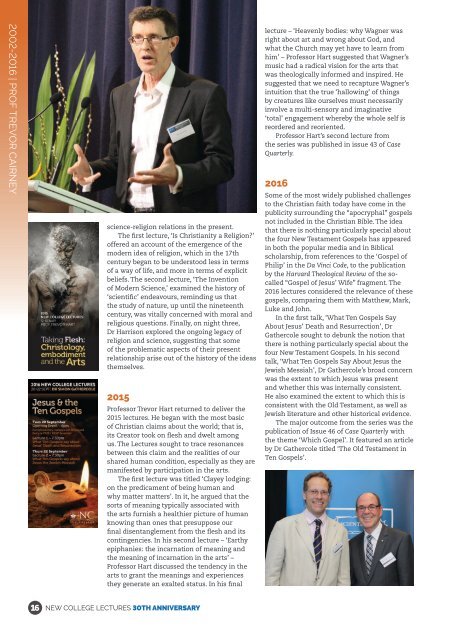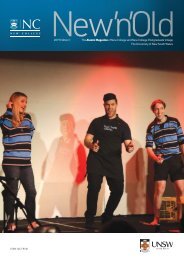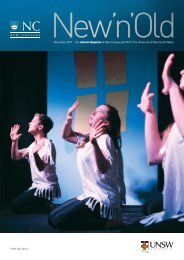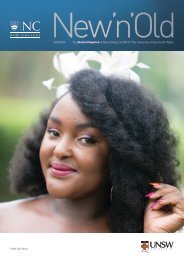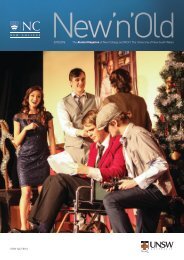You also want an ePaper? Increase the reach of your titles
YUMPU automatically turns print PDFs into web optimized ePapers that Google loves.
2002-2016 | PROF TREVOR CAIRNEY<br />
science-religion relations in the present.<br />
The first lecture, ‘Is Christianity a Religion?’<br />
offered an account of the emergence of the<br />
modern idea of religion, which in the 17th<br />
century began to be understood less in terms<br />
of a way of life, and more in terms of explicit<br />
beliefs. The second lecture, ‘The Invention<br />
of Modern Science,’ examined the history of<br />
‘scientific’ endeavours, reminding us that<br />
the study of nature, up until the nineteenth<br />
century, was vitally concerned with moral and<br />
religious questions. Finally, on night three,<br />
Dr Harrison explored the ongoing legacy of<br />
religion and science, suggesting that some<br />
of the problematic aspects of their present<br />
relationship arise out of the history of the ideas<br />
themselves.<br />
2015<br />
Professor Trevor Hart returned to deliver the<br />
2015 lectures. He began with the most basic<br />
of Christian claims about the world; that is,<br />
its Creator took on flesh and dwelt among<br />
us. The Lectures sought to trace resonances<br />
between this claim and the realities of our<br />
shared human condition, especially as they are<br />
manifested by participation in the arts.<br />
The first lecture was titled ‘Clayey lodging:<br />
on the predicament of being human and<br />
why matter matters’. In it, he argued that the<br />
sorts of meaning typically associated with<br />
the arts furnish a healthier picture of human<br />
knowing than ones that presuppose our<br />
final disentanglement from the flesh and its<br />
contingencies. In his second lecture – ‘Earthy<br />
epiphanies: the incarnation of meaning and<br />
the meaning of incarnation in the arts’ –<br />
Professor Hart discussed the tendency in the<br />
arts to grant the meanings and experiences<br />
they generate an exalted status. In his final<br />
lecture – ‘Heavenly bodies: why Wagner was<br />
right about art and wrong about God, and<br />
what the Church may yet have to learn from<br />
him’ – Professor Hart suggested that Wagner’s<br />
music had a radical vision for the arts that<br />
was theologically informed and inspired. He<br />
suggested that we need to recapture Wagner’s<br />
intuition that the true ‘hallowing’ of things<br />
by creatures like ourselves must necessarily<br />
involve a multi-sensory and imaginative<br />
‘total’ engagement whereby the whole self is<br />
reordered and reoriented.<br />
Professor Hart’s second lecture from<br />
the series was published in issue 43 of Case<br />
Quarterly.<br />
2016<br />
Some of the most widely published challenges<br />
to the Christian faith today have come in the<br />
publicity surrounding the “apocryphal” gospels<br />
not included in the Christian Bible. The idea<br />
that there is nothing particularly special about<br />
the four New Testament Gospels has appeared<br />
in both the popular media and in Biblical<br />
scholarship, from references to the ‘Gospel of<br />
Philip’ in the Da Vinci Code, to the publication<br />
by the Harvard Theological Review of the socalled<br />
“Gospel of Jesus’ Wife” fragment. The<br />
2016 lectures considered the relevance of these<br />
gospels, comparing them with Matthew, Mark,<br />
Luke and John.<br />
In the first talk, ‘What Ten Gospels Say<br />
About Jesus’ Death and Resurrection’, Dr<br />
Gathercole sought to debunk the notion that<br />
there is nothing particularly special about the<br />
four New Testament Gospels. In his second<br />
talk, ‘What Ten Gospels Say About Jesus the<br />
Jewish Messiah’, Dr Gathercole’s broad concern<br />
was the extent to which Jesus was present<br />
and whether this was internally consistent.<br />
He also examined the extent to which this is<br />
consistent with the Old Testament, as well as<br />
Jewish literature and other historical evidence.<br />
The major outcome from the series was the<br />
publication of Issue 46 of Case Quarterly with<br />
the theme ‘Which Gospel’. It featured an article<br />
by Dr Gathercole titled ‘The Old Testament in<br />
Ten Gospels’.<br />
16 NEW COLLEGE LECTURES 30TH ANNIVERSARY


